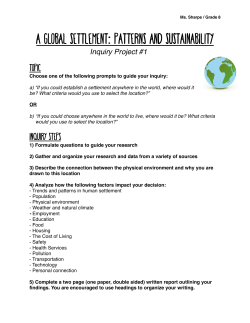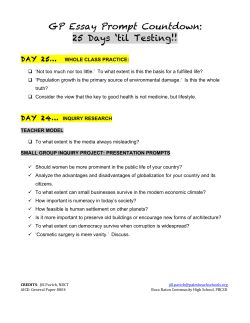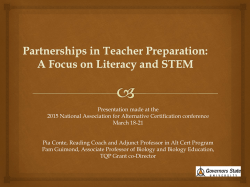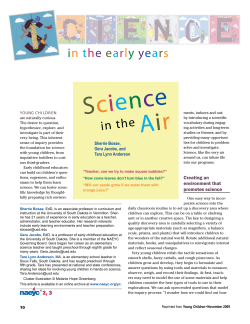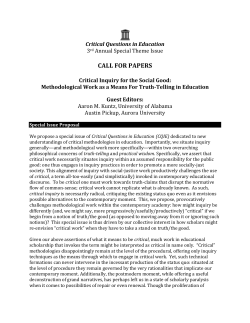
Objective #12
POD —IDEA Center Learning Notes S e p t e m b e r 2 0 0 6 Michael Theall, Youngstown State University, Series Editor IDEA Learning Objective #12: “Acquiring an interest in learning more by asking questions and seeking answers” Virginia S. Lee, Virginia S. Lee & Associates, LLC, vslee@virginiaslee.com Patricia Shaw, University of Wisconsin-Stevens Point, pshaw@uwsp.edu Leone Snyder, Capella University, lsnyder@capella.edu Background The ability to ask good questions and both find and develop well-supported answers is a hallmark of intellectual growth and development and a sophisticated learner (1). Stages of intellectual growth and development in the college years identified by Perry (2) and, later, Belenky et al. (3) acknowledge students’ growing recognition that knowledge is constructed, not given; that the marshalling of convincing evidence determines the merit of competing value claims; and that the discovery and use of one’s own voice is a critical aspect of intellectual maturity. In addition, approaches to general education have changed from emphasizing the importance of breadth in academic preparation to introducing students to the methods of inquiry of the disciplines (4). As students progress through their programs they become more adept at the kinds of questions and methods of seeking answers appropriate to their chosen majors and disciplines. As expressions of uncertainty and doubt, questions are a critical part of learning as a process of inquiry, animated by the posing of questions and problems and their resolution. The learner inquires or asks questions that prompt further discovery, search, and knowledge seeking. A variety of sources suggest that genuine uncertainty and doubt are the natural provocations for real learning (5, 6). The importance of uncertainty in learning is fully acknowledged in the loose body of theories called “constructivism” in which learners construct their own knowledge and meaning. For example, Jean Piaget, the renowned developmental psychologist, saw children as amateur scientists whose cognitive development advances through active exploration of the environment. Repeatedly new experiences cause them to question and modify their existing theories about how the world works. Similarly the foundation of American pragmatism and the later work of John Dewey, the philosopher and progressive educator, rest on the seminal work of Charles Pierce. Pierce (7) characterized the rhythm of real thinking as corresponding to scientific methods of inquiry. Like Piaget he asserted that “the action of thought is excited by the irritation of doubt, and ceases when belief is attained.” Each belief is at once a “stopping-place… [and] a new starting-place for thought” (p. 12). Learning objective 12 is one of two objectives related to a focus on lifelong learning or encouraging the pursuit of learning after one’s formal education is completed. (The other is objective 9 concerning finding and using resources for answering questions and solving problems.) It is also very consistent with a generally acknowledged aim of liberal education: developing an “inquiring mind.” Helpful Hints Relationships to other IDEA resources. IDEA research has shown that instructors who are successful in facilitating student progress on this objective, address it in situations using skill development and practice as opposed to a standard lecture-based approach (8). The seminar, normally a smaller class in which instructors and students together engage in critical discussion of readings or other course material, works well. Similarly discussion in conjunction with a skill activity, i.e., cognition and doing, a combination one might find in a lab, clinical or other professional setting, would also promote students’ active engagement through posing questions and seeking answers. For example, in problem-based learning—originally used in the education of engineers and physicians and now practiced in many disciplines, students confront problems like those they will encounter as practicing professionals, ask questions, and seek answers to their own questions as they solve problems. Not too surprisingly research has shown that problem-based learning promotes lifelong learning (9). IDEA has resources that also apply. POD-IDEA Center Notes on several items in the IDEA questionnaire (e.g., Notes 4. Demonstrated importance of the subject, 8. Stimulated student interest, 13. Introduced stimulating ideas, and 15. Inspired students to set challenging goals) are useful since these items are strongly related to this objective. This cluster of items (dealing with stimulating student interest) is particularly important and it emphasizes the need to engage students in active inquiry as part of developing both their interest and their skills. Some practical suggestions. For many instructors, teaching through student inquiry may require a fundamental shift in their thinking about teaching and learning and actual classroom practice. In order to acquire an interest in learning more by asking questions and seeking answers, students have to be given opportunities to do so. The following suggestions may help as you try to incorporate more opportunities for students to ask questions and seek answers: 1. Fostering learning through inquiry involves adaptations to the entire learning environment, including the kinds of classroom activities students do and how they are evaluated on their learning (10). The best way to align what and how we teach students and how we evaluate them is through the development of explicit outcomes. Generally, outcomes related to critical thinking, problem solving, and developing skills for lifelong learning are consistent with students learning how to ask questions and seek answers. 2. Explicitly teach students how to ask good questions in your discipline; about different kinds of questions; and about the kinds of answers they are likely to yield. For example, there are closed and open-ended questions; questions at different levels of Bloom’s taxonomy (11), and questions whose answers are facts, opinions or judgments that students will need to support with evidence (12). You can model good questioning strategies for students, ask questions of students and make explicit the kind of question you’re asking, or have students ask their own questions, experimenting with different types (see POD-IDEA Center Note #2 “Found ways to help students answer their own questions”). 3. Teaching methods such as inquiry-guided learning (1), discovery learning, problem-based learning (13) and case studies (see http://ublib.buffalo.edu/libraries/projects/cases/c ase.html) usually provide opportunities for students to ask their own questions and/or seek answers to their own or others’ questions. So does undergraduate research, while exclusive reliance on the traditional lecture generally does not. 4. There are a variety of ways to support or scaffold student inquiry. Bonnstetter (14) proposed a continuum of inquiry with structured inquiry in which students reach their own conclusions based on supportive evidence in the context of a structured hands-on experience designed by the instructor at one end and independent student research, mentored by an instructor, at the other end. In addition, various heuristics such as the IDEAL Problem Solver, the MORE Thinking Frame, vee diagrams and concept maps make explicit the underlying structure of problem solving and inquiry (5). 5. The following general classroom practices also encourage student initiative in learning: • letting student responses, interests and choices drive lessons, shift instructional strategies, and alter content; • having students share their understanding of concepts prior to sharing your own understanding of those concepts; encouraging students to engage in dialogue with and to ask thoughtful, open-ended questions of the teacher and one another; • seeking elaboration of students’ initial responses by asking probing, open-ended questions; • engaging students in discussions and experiences that may engender contradictions to their initial hypotheses; • fostering students’ natural curiosity by encouraging them to question concepts; • framing discussions and tasks using explicit cognitive terminology such as “classify,” “analyze,” “predict,” and “create”; and • having students work with raw data and primary sources, along with manipulative, interactive, and physical materials (15). Assessment Issues Assessing students’ ability to ask good questions and both find and develop well-supported answers may be challenging for instructors accustomed to traditional evaluation methods such as paper-andpencil exams. Lee et. al. (16) provide a useful table for matching generic stages of inquiry (e.g., question, results, discussion) with selected methods of assessment (e.g., developing a researchable question, generating hypotheses, organizing and analyzing data, interpreting data). You can assess only students’ ability to ask good questions, for example, by presenting a set of data and asking students to create questions answerable by those data. You can create similarly small assignments for other stages in the process of inquiry as well. Bean (17) also provides a number of examples of assignments that assess specific skills of inquiry. You can use these mini-assignments to assess student learning as well as the effectiveness of your own instruction. For the latter purpose these assignments function as classroom assessment techniques. For example, Angelo and Cross (18) include several ways to assess learner attitudes and values as well as learner reactions to instruction and class activities. Aggregating and analyzing student results on these miniassessments can yield helpful feedback on where student understanding is weak, which can in turn provide guidance on how to modify instruction to promote better understanding. A related way to involve students in questioning their understanding is the use of “knowledge surveys” (19). Rather than directly assessing content knowledge, these assessment tools ask students to consider their degree of confidence in their ability to respond correctly to content questions. When students compare their presumed knowledge to their actual knowledge, they identify areas of strength and weakness that they or their teachers can use to alter and improve teaching and learning (20). For more major assignments that assess students’ ability to ask good questions and develop wellsupported answers (e.g., research proposals, experiment design, lab report), you may still wish to assess each stage of the assignment separately. Walvoord and Andersen (21) provide excellent guidance on how to do this using rubrics (i.e., scoring guides; 22). IDEA research has also found it important for instructors to explain “the reasons and criticisms of students’ academic performance (see POD-IDEA Center Note #7). Establishing observable anchors for each level of performance (i.e., excellent (A), good (B), fair (C) and poor (D, F)) both conveys explicit expectations to students when they receive rubrics when the assignment is given, and facilitates more objective grading and more specific feedback to students on their actual performance on an assignment. Analyzing students’ aggregate performance on the assignment using the rubric will also help you assess the effectiveness of your teaching and provide guidance on how to improve it. References and Resources (1) Lee, V.S. (Ed.). (2004). Teaching and learning through inquiry: A guidebook for institutions and instructors. Sterling, VA: Stylus. (2) Perry, W.G., Jr. (1970). Forms of intellectual and ethical development in the college years: A scheme. New York: Holt, Rinehart, and Winston. (3) Belenky, M. F., Clinchy, B. M., Goldberger, N. R., & Tarule, J. M. (1986). Women’s ways of knowing: The development of self, voice, and mind. New York, NY: Basic Books. (4) Schneider, C.G., & Shoenberg, R. (1998). Contemporary understandings of liberal education. Washington, D.C.: American Association of Colleges and Universities. (5) Lee, V.S. (2003). Vees, thinking frames, and concept maps: Supporting student thought and inquiry. National Teaching and Learning Forum, 12 (4), 1-4. (6) Lee, V.S. (1998). The uses of uncertainty in the college classroom. Essays on Teaching Excellence, 10 (1). Valdosta, GA: POD Network in Higher Education. (7) Peirce, C. (1878). How to make our ideas clear. Popular Science Monthly, January, 286-302. (8) Hoyt, D. P., & Perera, S. (2000). IDEA research report #1: Teaching approach, instructional objectives, and learning. Manhattan, KS: The IDEA Center. Retrieved September 20, 2006 from www.idea.ksu.edu/reports/research1.pdf. (9) Albanese, M.A., & Mitchell, S. (1993). Problembased learning: A review of literature on its outcomes and implementation issues. Academic Medicine, 68 (1). (10) Slick, S., Upham, D., & Shaw, P. (2005). Making assignments invitations to possibilities. Presentation at the 17th Annual Lilly Conference on College & University Teaching – West, March 18-19, Pomona, CA. (11) Bloom, B. S. (Ed.). (1956). Taxonomy of educational objectives: Book 1 cognitive domain. New York: Longman. (12) Paul, R. W. (1993). Critical thinking: What every person needs to survive in a rapidly changing world. Santa Rosa, CA: The Foundation for Critical Thinking. (13) Duch, B. J., Groh, S.E., & Allen, D.E. (2001). The power of problem-based learning. Sterling, VA: Stylus. (14) Bonstetter, R. J. (1998). Inquiry: Learning from the past with an eye to the future. Electronic Journal of Science Education, 3 (1). Retrieved September 20, 2006 from http://www.asd.k12.ak.us/depts/science/element ary/inquiry.htm. (15) Shaw, P. (2006). Educational Psychology. Unpublished course syllabus. University of Wisconsin-Stevens Point. (16) Lee, V.S., Greene, D.B., Odom, J., Schechter, E., & Slatta, R. (2004). What is inquiry- guided learning? In V.S. Lee (Ed.) Teaching and learning through inquiry: A guidebook for institutions and instructors. Sterling, VA: Stylus. See pages 12-13. (17) Bean, J.D. (1996). Engaging ideas: the professor’s guide to integrating writing, critical thinking, and active learning in the classroom. San Francisco: Jossey-Bass. (18) Angelo, T., & Cross, K.P. (1993). Classroom assessment techniques: A handbook for college teachers (2nd Edition). San Francisco: Jossey-Bass. See pages 255-362. (19) Bowers, N., Brandon, M., & Hill, C. D. (2005). The use of a knowledge survey as an indicator of student learning in an introductory biology. Course Cell Biology 4 (4), 311-322. Retrieved September 20, 2006 from http://www.pubmedcentral.nih.gov/articlerender. fcgi?artid=1305893 (20) Nuhfer, E. (2005). Knowledge surveys. Description and workshop outline retrieved September 20, 2006 from http://honolulu.hawaii.edu/intranet/committees/FacD evCom/guidebk/teachtip/knowlsurvey.htm (21) Walvoord, B.E., & Andersen, V.J. (1998). Effective grading: A tool for learning and assessment. San Francisco: Jossey-Bass. (22) For examples, see http://its.monmouth.edu/facultyresourcecenter/r ubrics.htm and http://www.uwstout.edu/soe/profdev/webpageru bric.html Retrieved September 20, 2006. Related POD-IDEA Center Notes IDEA Item #1 "Displayed a personal interest in students and their learning," Virginia S. Lee IDEA Item #2 "Found ways to help students answer their own questions," Nancy McClure IDEA Item #4 "Demonstrated the importance and significance of the subject matter," Nancy McClure IDEA Item #6 "Made it clear how each topic fit into the course," Michael Theall IDEA Item #7 "Explained the reasons for criticisms of students' academic performance," Barbara E. Walvoord IDEA Item #8 "Stimulated students to intellectual effort beyond that required by most courses," Nancy McClure IDEA Item #13 "Introduced stimulating ideas about the subject," Michael Theall IDEA Item #15 "Inspired students to set and achieve goals which really challenged them," Todd Zakrajsek IDEA Item #18 "Asked students to help each other understand ideas or concepts," Jeff King Additional Resources IDEA Paper No. 31: Answering and Asking Questions, Cashin IDEA Paper No. 39: Establishing Rapport: Personal Interaction and Learning, Fleming IDEA Paper No. 41: Student Goal Orientation, Motivation, and Learning, Svinicki ©2006 The IDEA Center This document may be reproduced for educational/training activities. Reproduction for publication or sale may be done only with prior written permission of The IDEA Center.
© Copyright 2025
